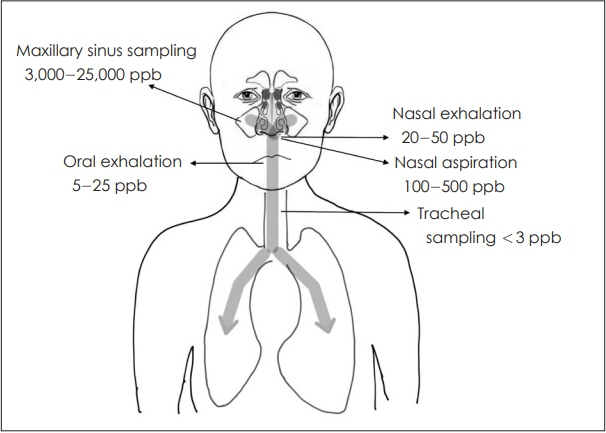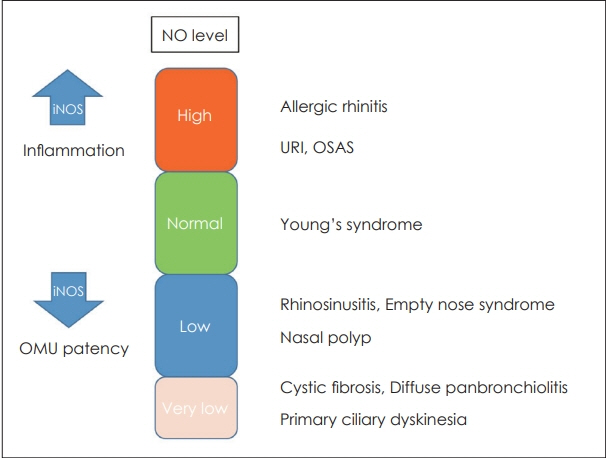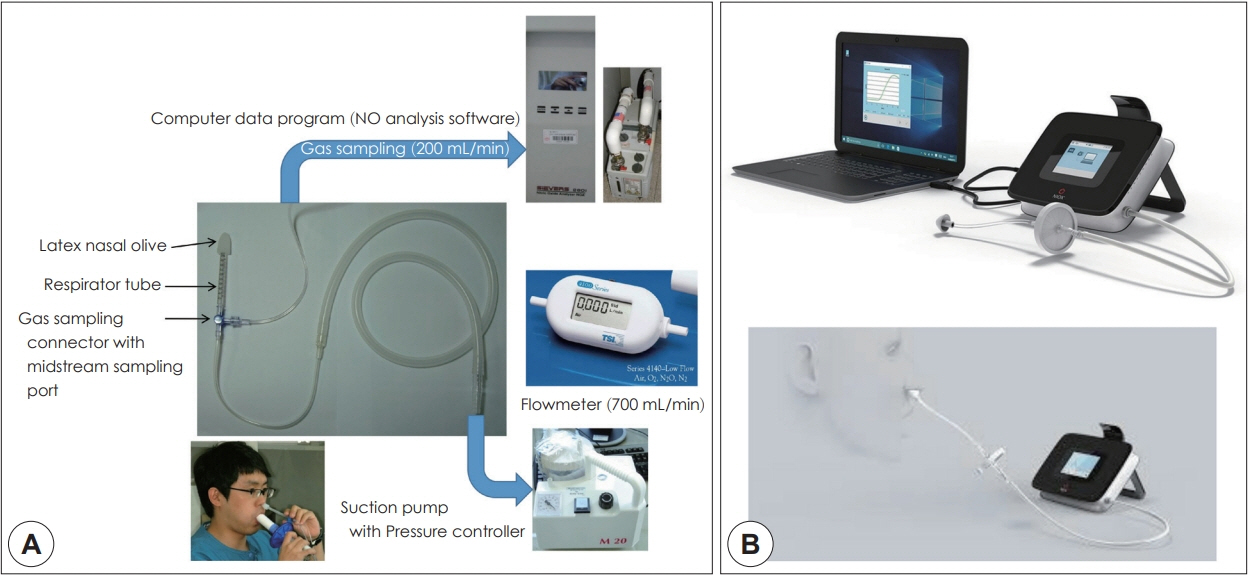J Rhinol.
2021 Jul;28(2):81-88. 10.18787/jr.2021.00361.
Nasal Nitric Oxide in the Upper Airway Inflammatory Diseases
- Affiliations
-
- 1Department of Otolaryngology-Head & Neck Surgery, Hanyang University College of Medicine, Seoul, Korea
- KMID: 2518672
- DOI: http://doi.org/10.18787/jr.2021.00361
Abstract
- Exhaled nitric oxide (eNO) from the lower respiratory tract is used commonly in diagnosis and treatment monitoring of asthma patients. However, nasal nitric oxide (nNO) has not been widely used in patients with upper airway inflammatory diseases due to its lack of standardized measurement methods. Nasal nitric oxide is produced mainly by the paranasal sinus mucosa and partially by the nasal mucosa and increases with inflammation. Nasal nitric oxide not only locally supports the defensive mechanism of the upper respiratory tract, but also remotely controls pulmonary function by acting as an aerocrine. Nasal NO can be affected by various physiologic and pathologic factors of the upper respiratory tract. This article will review the origin of nNO, its function, various measurement methods, and difference in presentation among upper respiratory tract inflammatory diseases such as allergic rhinitis, upper respiratory tract infection, nasal polyp, rhinosinusitis, primary ciliary dyskinesia, cystic fibrosis, Young’s syndrome, diffuse panbronchiolitis, empty nose syndrome, and obstructive sleep apnea. Future studies should identify the mechanism of action of nNO in various upper respiratory tract inflammatory diseases and obtain highly reproducible normal values of nNO based on a standardized measurement method with a deeper understanding of factors affecting nNO. Then, nNO will be useful for more rapid and simpler diagnosis of various upper respiratory tract diseases and for monitoring their treatment.
Keyword
Figure
Reference
-
References
1. Moncada S, Palmer RM, Higgs EA. Nitric oxide: physiology, pathophysiology, and pharmacology. Pharmacol Rev. 1991; 43:109–42.2. Palmer RM, Ferrige AG, Moncada S. Nitric oxide release accounts for the biological activity of endothelium-derived relaxing factor. Nature. 1987; 327:524–6.3. Alving K, Weitzberg E, Lundberg JM. Increased amount of nitric oxide in exhaled air of asthmatics. Eur Respir J. 1993; 6:1368–70.4. Lim KG, Mottram C. The use of fraction of exhaled nitric oxide in pulmonary practice. Chest. 2008; 133(5):1232–42.5. Shaw DE, Berry MA, Thomas M, Green RH, Brightling CE, Wardlaw AJ, et al. The use of exhaled nitric oxide to guide asthma management: a randomized controlled trial. Am J Respir Crit Care Med. 2007; 176(3):231–7.6. Lundberg JO, Rinder J, Weitzberg E, Lundberg JM, Alving K. Nasally exhaled nitric oxide in humans originates mainly in the paranasal sinuses. Acta Physiol Scand. 1994; 152(4):431–2.7. Lundberg JO, Farkas-Szallasi T, Weitzberg E, Rinder J, Lidholm J, Anggaard A, et al. High nitric oxide production in human paranasal sinuses. Nat Med. 1995; 1:370–3.8. Kawamoto H, Takeno S, Yajin K. Increased expression of inducible nitric oxide synthase in nasal epithelial cells in patients with allergic rhinitis. Laryngoscope. 1999; 109:2015–20.9. Maniscalco M, Sofia M, Pelaia GL. Nitric oxide in upper airways inflammatory diseases. Inflamm Res. 2007; 56(2):58–69.10. Mancinelli RL, McKay CP. Effects of nitric oxide and nitrogen dioxide on bacterial growth. Appl Environ Microbiol. 1983; 46:198–202.11. Jain B, Rubinstein I, Robbins RA, Leise KL, Sisson JH. Modulation of airway epithelial cell ciliary beat frequency by nitric oxide. Biochem Biophys Res Commun. 1993; 191(1):83–8.12. Holden WE, Wilkins JP, Harris M, Milczuk HA, Giraud GD. Temperature conditioning of nasal air: effects of vasoactive agents and involvement of nitric oxide. J Appl Physiol. 1999; 87:1260–5.13. Lundberg JO, Lundberg JM, Settergren G, Alving K, Weitzberg E. Nitric oxide, produced in the upper airways, may act in an ‘aerocrine’ fashion to enhance pulmonary oxygen uptake in humans. Acta Physiol Scand. 1995; 155:467–8.14. Arnal JF, Didier A, Rami J, M’Rini C, Charlet JP, Serrano E, et al. Nasal nitric oxide is increased in allergic rhinitis. Clin Exp Allergy. 1997; 27:358–62.15. Kharitonov SA, Rajakulasingam K, O’Connor B, Durham SR, Barnes PJ. Nasal nitric oxide is increased in patients with asthma and allergic rhinitis and may be modulated by nasal glucocorticoids. J Allergy Clin Immunol. 1997; 99:58–64.16. Martin U, Bryden K, Devoy M, Howarth P. Increased levels of exhaled nitric oxide during nasal and oral breathing in subjects with seasonal rhinitis. J Allergy Clin Immunol. 1996; 97:768–72.17. Sato M, Fukuyama N, Sakai M, Nakazawa H. Increased nitric oxide in nasal lavage fluid and nitrotyrosine formation in nasal mucosa- indices for severe perennial nasal allergy. Clin Exp Allergy. 1998; 28:597–605.18. Lee KJ, Cho SH, Lee SH, Tae K, Yoon HJ, Kim SH, et al. Nasal and exhaled nitric oxide in allergic rhinitis. Clin Exp Otorhinolaryngol. 2012; 5(4):228–33.19. Wang PP, Wang GX, Ge WT, Tang LX, Zhang J, Ni X. Nasal nitric oxide in allergic rhinitis in children and its relationship to severity and treatment. Allergy Asthma Clin Immunol. 2017; 13:20.20. Ren L, Zhang W, Zhang Y, Zhang L. Nasal Nitric Oxide Is Correlated With Nasal Patency and Nasal Symptoms. Allergy Asthma Immunol Res. 2019; 11(3):367–80.21. Takeno S, Okabayashi Y, Kohno T, Yumii K, Hirakawa K. The role of nasal fractional exhaled nitric oxide as an objective parameter independent of nasal airflow resistance in the diagnosis of allergic rhinitis. Auris Nasus Larynx. 2017; 44(4):435–41.22. Hou J, Lou H, Wang Y, He F, Cao F, Wang C, et al. Nasal ventilation is an important factor in evaluating the diagnostic value of nasal nitric oxide in allergic rhinitis. Int Forum Allergy Rhinol. 2018; 8(6):686–94.23. Takahara D, Kono T, Takeno S, Ishino T, Hamamoto T, Kubota K, et al. Nasal nitric oxide in the inferior turbinate surface decreases with intranasal steroids in allergic rhinitis: a prospective study. Auris Nasus Larynx. 2019; 46(4):507–12.24. Baraldi E, Azzolin NM, Carra S, Dario C, Marchesini L, Zacchello F. Effect of topical steroids on nasal nitric oxide production in children with perennial allergic rhinitis: a pilot study. Respir Med. 1998; 92:558–61.25. Wilson AM, Dempsey OJ, Sims EJ, Lipworth BJ. Subjective and objective markers of treatment response in patients with seasonal allergic rhinitis. Ann Allergy Asthma Immunol. 2000; 85:111–4.26. Wilson AM, Dempsey OJ, Sims EJ, Lipworth BJ. A comparison of topical budesonide and oral montelukast in seasonal allergic rhinitis and asthma. Clin Exp Allergy. 2001; 31:616–24.27. Ambrosino P, Parrella P, Formisano R, Papa A, Spedicato GA, Di Minno MND, et al. Clinical application of nasal nitric oxide measurement in allergic rhinitis: a systematic review and meta-analysis. Ann Allergy Asthma Immunol. 2020; 125(4):447–59.28. Sanders SP, Siekierski ES, Richards SM, Porter JD, Imani F, Proud D. Rhinovirus infection induces expression of type 2 nitric oxide synthase in human respiratory epithelial cells in vitro and in vivo. J Allergy Clin Immunol. 2001; 107:235–43.29. Sanders SP, Proud D, Permutt S, Siekierski ES, Yachechko R, Liu MC. Role of nasal nitric oxide in the resolution of experimental rhinovirus infection. J Allergy Clin Immunol. 2004; 113:697–702.30. Kharitonov SA, Yates D, Barnes PJ. Increased nitric oxide in exhaled air of normal human subjects with upper respiratory tract infections. Eur Respir J. 1995; 8:295–7.31. Rouby JJ. The nose, nitric oxide, and paranasal sinuses: the outpost of pulmonary antiinfectious defenses? Am J Respir Crit Care Med. 2003; 168:265–6.32. Sadek AA, Abdelwahab S, Eid SY, Almaimani RA, Althubiti MA, El-Readi MZ. Overexpression of Inducible Nitric Oxide Synthase in Allergic and Nonallergic Nasal Polyp. Oxid Med Cell Longev. 2019; 2019:7506103.33. Ambrosino P, Molino A, Spedicato GA, Parrella P, Formisano R, Motta A, et al. Nasal Nitric Oxide in Chronic Rhinosinusitis with or without Nasal Polyps: a Systematic Review with Meta-Analysis. J Clin Med. 2020; 9(1):200.34. Jeong JH, Yoo HS, Lee SH, Kim KR, Yoon HJ, Kim SH. Nasal and exhaled nitric oxide in chronic rhinosinusitis with polyps. Am J Rhinol Allergy. 2014; 28(1):e11–6.35. Ragab SM, Lund VJ, Saleh HA, Scadding G. Nasal nitric oxide in objective evaluation of chronic rhinosinusitis therapy. Allergy. 2006; 61:717–24.36. Arnal JF, Flores P, Rami J, Murris-Espin M, Bremont F, Pasto IAM, et al. Nasal nitric oxide concentration in paranasal sinus inflammatory diseases. Eur Respir J. 1999; 13:307–12.37. Colantonio D, Brouillette L, Parikh A, Scadding GK. Paradoxical low nasal nitric oxide in nasal polyposis. Clin Exp Allergy. 2002; 32(5):698–701.38. Yoshida K, Takabayashi T, Imoto Y, Sakashita M, Narita N, Fujieda S. Reduced nasal nitric oxide levels in patients with eosinophilic chronic rhinosinusitis. Allergol Int. 2019; 68(2):225–32.39. Zhu M, Gao X, Zhu Z, Hu X, Zhou H, Liu J. The roles of nasal nitric oxide in diagnosis and endotypes of chronic rhinosinusitis with nasal polyps. J Otolaryngol Head Neck Surg. 2020; 49(1):68.40. Lindberg S, Cervin A, Runer T. Nitric oxide (NO) production in the upper airways is decreased in chronic sinusitis. Acta Otolaryngol. 1997; 117:113–7.41. Deja M, Busch T, Bachmann S, Riskowski K, Campean V, Wiedmann B, et al. Reduced nitric oxide in sinus epithelium of patients with radiologic maxillary sinusitis and sepsis. Am J Respir Crit Care Med. 2003; 168:281–6.42. Baraldi E, Azzolin NM, Biban P, Zacchello F. Effect of antibiotic therapy on nasal nitric oxide concentration in children with acute sinusitis. Am J Respir Crit Care Med. 1997; 155:1680–3.43. Degano B, Genestal M, Serrano E, Rami J, Arnal JF. Effect of treatment on maxillary sinus and nasal nitric oxide concentrations in patients with nosocomial maxillary sinusitis. Chest. 2005; 128:1699–705.44. Fu CH, Tseng HJ, Huang CC, Chang PH, Chen YW, Lee TJ. Nasal nitric oxide in unilateral sinus disease. PLoS One. 2017; 12(2):e0171965.45. Corbelli R, Bringolf-Isler B, Amacher A, Sasse B, Spycher M, Hammer J. Nasal nitric oxide measurements to screen children for primary ciliary dyskinesia. Chest. 2004; 126:1054–9.46. Loukides S, Kharitonov S, Wodehouse T, Cole PJ, Barnes PJ. Effect of arginine on mucociliary function in primary ciliary dyskinesia. Lancet. 1998; 352:371–2.47. Niebroj-Dobosz I, Hausmanowa-Petrusewicz I. The involvement of oxidative stress in determining the severity and progress of pathological processes in dystrophin-deficient muscles. Acta Biochim Pol. 2005; 52:449–52.48. Balfour-Lynn IM, Laverty A, Dinwiddie R. Reduced upper airway nitric oxide in cystic fibrosis. Arch Dis Child. 1996; 75:319–22.49. Zheng S, Xu W, Bose S, Banerjee AK, Haque SJ, Erzurum SC. Impaired nitric oxide synthase-2 signaling pathway in cystic fibrosis airway epithelium. Am J Physiol Lung Cell Mol Physiol. 2004; 287:L374–81.50. Wodehouse T, Kharitonov SA, Mackay IS, Barnes PJ, Wilson R, Cole PJ. Nasal nitric oxide measurements for the screening of primary ciliary dyskinesia. Eur Respir J. 2003; 21:43–7.51. Nakano H, Ide H, Imada M, Osanai S, Takahashi T, Kikuchi K, et al. Reduced nasal nitric oxide in diffuse panbronchiolitis. Am J Respir Crit Care Med. 2000; 162:2218–20.52. Fu CH, Wu CL, Huang CC, Chang PH, Chen YW, Lee TJ. Nasal nitric oxide in relation to psychiatric status of patients with empty nose syndrome. Nitric Oxide. 2019; 92:55–59.53. Zhang D, Luo J, Qiao Y, Xiao Y, Huang R, Zhong X. Measurement of exhaled nitric oxide concentration in patients with obstructive sleep apnea: a meta-analysis. Medicine. 2017; 96(12):e6429.54. Zhang D, Xiao Y, Luo J, Wang X, Qiao Y, Huang R, et al. Measurement of fractional exhaled nitric oxide and nasal nitric oxide in male patients with obstructive sleep apnea. Sleep Breath. 2019; 23(3):785–93.55. Hamada S, Tatsumi S, Kobayashi Y, Yasuba H. Nasal nitric oxide improved by continuous positive airway pressure therapy for upper airway inflammation in obstructive sleep apnea. Sleep Breath. 2017; 21(2):405–10.56. Gut G, Tauman R, Greenfeld M, Armoni-Domany K, Sivan Y. Nasal nitric oxide in sleep-disordered breathing in children. Sleep Breath. 2016; 20(1):303–8.57. Kharitonov S, Alving K, Barnes PJ. Exhaled and nasal nitric oxide measurements: recommendations. The European Respiratory Society Task Force. Eur Respir J. 1997; 10:1683–93.58. ATS/ERS. Recommendations for Standardized Procedures for the Online and Offline Measurement of Exhaled Lower Respiratory Nitric Oxide and Nasal Nitric Oxide, 2005. Am J Respir Crit Care Med. 2005; 171:912–30.59. Tanabe Y, Harada N, Ito J, Matsuno K, Takeshige T, Harada S, et al. Difference between two exhaled nitric oxide analyzers, NIOX VERO® electrochemical hand-held analyzer and NOA280i® chemiluminescence stationary analyzer. J Asthma. 2019; 56(2):167–72.60. Qian W, Djupesland PG, Chatkin JM, McClean P, Furlott H, Chapnik JS, et al. Aspiration flow optimized for nasal nitric oxide measurement. Rhinology. 1999; 37:61–5.61. Kharitonov SA, Barnes PJ. Nasal contribution to exhaled nitric oxide during exhalation against resistance or during breath holding. Thorax. 1997; 52:540–4.62. Djupesland PG, Chatkin JM, Qian W, Cole P, Zamel N, McClean P, et al. Aerodynamic influences on nasal nitric oxide output measurements. Acta Otolaryngol. 1999; 119:479–85.63. Gelardi M, Abbattista G, Quaranta VN, Quaranta N, Seccia V, Buttafava S, et al. Standardization procedure for the nasal nitric oxide measurement method using Niox MINO and the tidal-breathing technique with velum-closure. J Biol Regul Homeost Agents. 2016; 30(3):853–8.64. Weitzberg E, Lundberg JO. Humming greatly increases nasal nitric oxide. Am J Respir Crit Care Med. 2002; 166:144–5.65. Maniscalco M, Weitzberg E, Sundberg J, Sofia M, Lundberg JO. Assessment of nasal and sinus nitric oxide output using singlebreath humming exhalations. Eur Respir J. 2003; 22:323–9.66. Lundberg JO, Maniscalco M, Sofia M, Lundblad L, Weitzberg E. Humming, nitric oxide, and paranasal sinus obstruction. JAMA. 2003; 289:302–3.
- Full Text Links
- Actions
-
Cited
- CITED
-
- Close
- Share
- Similar articles
-
- The Role of Nitric Oxide in the Nasal Mucosa and Rhinitis
- Expression of Nitiric Oxide Synthase lsoenzymes in Normal Nasal and Polyp Mucosa of Human
- Expression of Inducible Nitric Oxide Synthase in Rat and Guinea PigRespiratory Epithelium after Capsaicin Treatment
- Expression of Inducible Nitric Oxide Synthase and Its Steroid Effect in TDI-Induced Nasal Hyperreactive Guinea Pigs
- Involvement of Fibronectin in the Migration of Macrophage and Expression of Nitric Oxide Synthase in the BCG induced Inflammatory Sites in Rat Bladder




